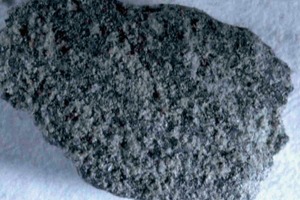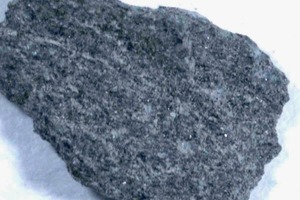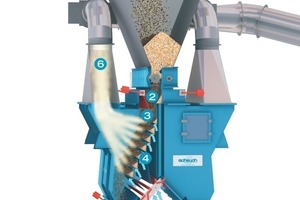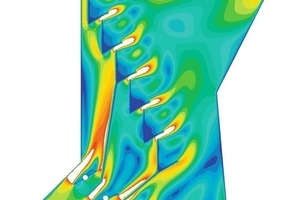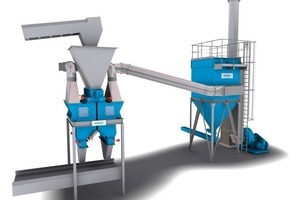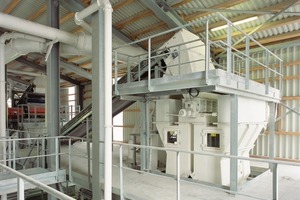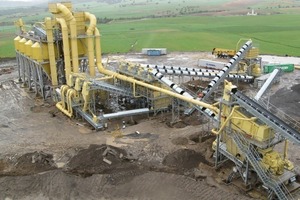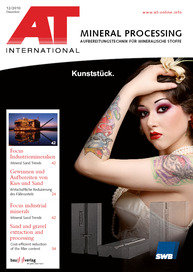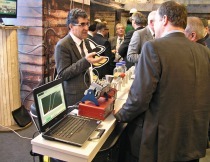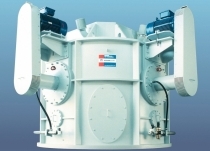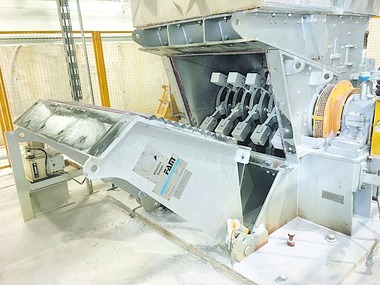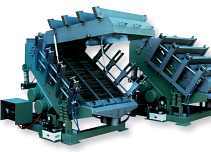Cost-efficient reduction of the filler content
In the extraction and further processing of natural and crushed sand, fine dust is formed as a result of abrasion in the crusher, in the screens and during handling. This content of fine dust with a grain size smaller than 90 μm is referred to as filler. The filler content formed in this way generally ranges between 15 and 25 %. As a filler content below 10 % or down to 5 % is needed for many applications, the content must be reduced to the specified value. Basically, two different processes are available to achieve this: wet and dry processes.
In wet-processing equipment, water is already added at the screens and the filler removed in a washing unit. The advantages of this system are that the filler content can be reduced to close to 0 %, the filler can be removed in the form of sludge, which is easier to landfill. For this multistage process, however, the investment costs are high and the design of the equipment is commensurately complex in respect of wear and corrosion. If a dry final material is required, this must be dried in special dryers, which again incurs investment and operating costs.
Dry processes, in contrast, are simpler and must be dedusted by means of filter equipment. The filler content can be reduced by means of special screens or a cascade classifier. As screens incur higher investment costs compared to classifiers and the screen decks have to be renewed at certain intervals owing to wear, the cascade classifier presents the more economic solution. Another advantage of the classifier is that it can be integrated into plant dedusting system at just limited additional cost.
The difficulty is in the breaking down of the agglomerates, i.e. to separate the fines from the coarse fraction and to achieve high efficiency in the separation of the coarse and fine particles in the air stream (Fig. 1 and Fig. 2). The volume of air is determined based on the near-size grain by adjusting the ascending rate of the air stream to the settling rate of the near-size grain. The near-size grain is the particle size 50 % of which is removed.
An important precondition for optimal filler removal is that the moisture content of the sand is below 1.5 %. The higher the moisture content, the higher the content of fine grain attached to the larger particles and the higher the shear forces needed to remove the this grain. For efficient separation and cost-effective operation, the material and air distribution over the entire width of the classifier should be as homogeneous as possible.
Based on the many years of experience in the classifying of various materials (for example, MDF fibres, sawdust, building rubble, crushed stone, waste), Scheuch GmbH has developed a cascade classifier especially for filler removal in the gravel and crushed stone industry.
The material is generally fed into the classifier (3) on a belt conveyor (1) and through a specially designed pendulum flap (2) from the top (Fig. 3). The pendulum flap minimizes the amount of air leaked into the classifier, therefore avoiding any adverse effects on the separation efficiency. The material flows from the top to the bottom over several cascades. The air necessary for classifying is sucked in from the bottom and blown in crosscurrent fashion through the material at high speed using the cascades, which function here as nozzles (4). This generates powerful shearing forces that separate the fine-grained from the coarse grained particles.
As the process proceeds, it is important to achieve a uniform upward flow in order to use gravity for further separation. In this process, coarse particles fall out of the bottom of the classifier through a pendulum flap (5) while the fine particles are entrained upward (6), fed to a dedusting system and discharged via a rotary valve.
By means of CFD simulation and design optimization, separating efficiency could be further improved (Fig. 4). Thanks to the more homogeneous air flow, the oversize content in the filler can be minimized and the filler removed more efficiently. Optionally, with forced air circulation, classifying efficiency can be further optimized with an additional fan above the air inlets being used to balance out the underpressure in the classifier and minimize the problematic leakage air at the material inlet and outlets. Besides outstanding separating efficiency, the filler content can be adjusted to different settings in the Scheuch cascade classifier. A 25 % filler content can, for example, be reliably reduced to 5 % or in favourable conditions even to a lower content of around 2 %.
In the development of the classifier, particular importance was attached to wear protection and therefore ensuring a longer lifetime of the plant. So, for example, with optimized air circulation in the classifier housing, peak speeds near the wall can be minimized, while other risk areas are fitted with wear-resistant, replaceable materials. This classifier can handle a material feed rate of 85 t/h; for higher material rates, individual cascade classifier lines are operated parallel.
With the design and supply of extraction and classifier plants from one source, Scheuch offers operators systems that are optimally geared to each other with maximized cost efficiency and availability (Fig. 5). During commissioning, the classifier settings are optimally adjusted by the service technician in line with the required filler removal, the settling rate of the near-size particles and the material moisture. The parameters can then be readjusted by the operator himself by adapting of the total air volume, for instance if the composition of the starting material changes or another filler removal rate or sizes of near-size grains are necessary. Since 2000, the first classifier based on this innovative system has been in operation at the crushed stone works in Gradenberg/Austria (Fig. 6), another 10 plants have since been installed in the field (Fig. 7).
Scheuch GmbH, Aurolzmünster (A),
Tel.: +43 7752 905-0, www.scheuch.com

